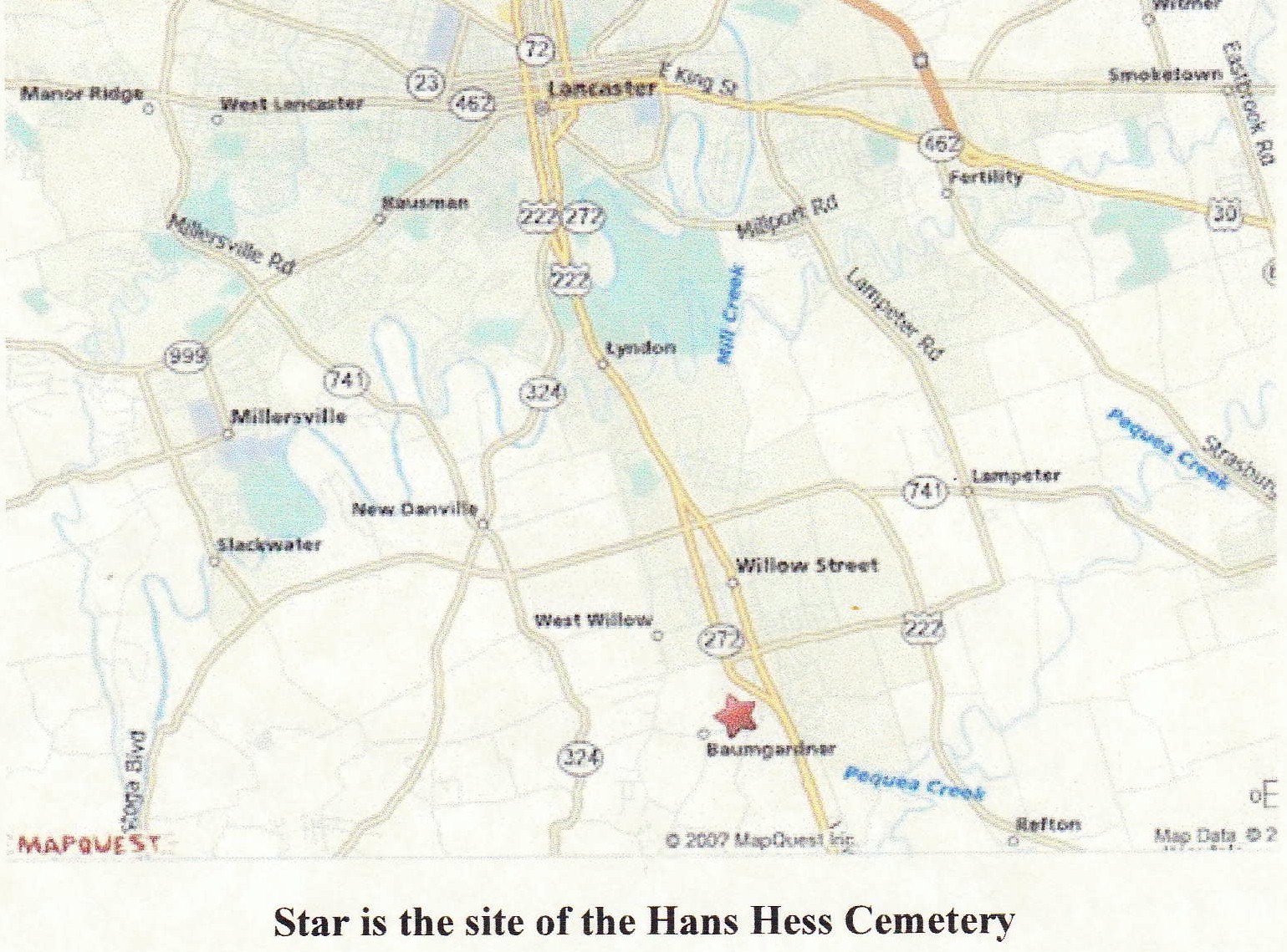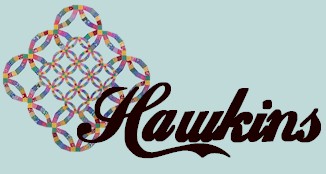|
Jacob and Barbara (Kendig) Boehme
Jacob Boehme was born in 1693 in Zweibrucken, Palatinate, Rheinland, Germany and died July 12, 1781 in Conestoga Township, Lancaster County, Pennsylvania. His will was dated September 18, 1778 in Lancaster County, Pennsylvania and probated July 12, 1781 in the same county. On November 20, 1724 in Lancaster County, Pennsylvania Jacob married Barbara Kendig. Barbara was born in 1695 in Switzerland and died in 1780 in Lancaster County, Pennsylvania. Both are buried in the Hans Hess Cemetery, Swigart Hill, Pennsylvania. Pequea Township Lancaster County Pennsylvania.
(Hans) Hess Family Graveyard is located on the hilt overlooking Baumgardner Rd, west of Boehm United Methodist church. The oldest legible gravestone of Has Hess, who died in 1733.

|
Jacob and Barbara had thirteen children:
Jacob Beam born before 1720 in Chester Co., Pennsylvania
Abraham Beam trorn before 1720 in Chester Co., Pennsylvania
Fronica Beam born after 1720 in Chester Co., Pennsylvania
John Beam born after 1722 in Chester Co., Pennsylvania
Mary Beam born after 1723 in Chester Co., Pennsylvania
Martin Beam born November 30, 1725 in Chester Co., Pennsylvania
Anna Beam born after 1726 in Chester Co., Pennsylvania
Elizabeth Beam born after 1727 in Chester Co., Pennsylvania
Barbara Beam born after 1728 in Chester Co., Pennsylvania
Tobias Beam born after 1737 in Lancaster Co., Pennsylvania
Sussannah Beam born February 12, 1734/35 in Lancaster Co., Pennsylvania
Magdalena Beam born January 5, 1738/39 in Lancaster Co., Pennsylvania

|
Jacob came to America in l717 from Palatinate to Pennsylvania. He was a blacksmith and farmer. Jacob is listed as giving "Patriotic Services" in the American Revolution War. The family were Mennonites.
Historical Papers and Addresses of the Lancaster County Historical Society
|
Then again, the Irish and Welsh settlers, who were neighbors to the Germans, had superstitions and folklore of their own; and we soon had evidence of the intermingling of the Celtic, Cymric and Teutonic traditions and customs, these becoming engrafted upon each other until we have what in some cases may be called a strictly Pennsylvania folk-lore.
The superstitions, or Aberglaube, of the early German settlers entered into all domestic actions and the duties of every-day life. No matter whether it was the sowing of seed, the reaping of the grain, starting upon a journey, the curing of any disorder in man or beat, the birth or baptism of a child, a marriage or a funeral - in each and every phase of common life there was interspersed more or less of this Aberglaube. This was especially true of the settlers of Germantown and the Conestoga country, who was imbued with the notions of mystical religion, and with the speculations of Jacob Boehme and others.
It is but due, however, to the clergy of the Lutheran and Reformed churches
to say that from the very first inception of the Reformation down to the present day they have consistently labored to stamp out this belief in signs,
omens, superstitions, and prognostics.
|
Reference:
Historical Papers and Addresses of the Lancaster County Historical Society
DAR Patriot lists
Research of Jim and Dorothy Galloway
Reminiscences, Historical and Biographical, of Rev. Henry Boehm
Religious Background of the Boehm Family of Lancaster Co., PA
Jacob Bohm (ca. 1693-1781), the Mennonite emigrant to Lancaster Co., PA, lived in a time of religious upheaval. Although the extant records indicate that Jacob was a devoutly religious man, within a few generations, this Boehm family changed religious affiliation several times. The family tradition, preserved by Rev. Henry BeamlBoehm in the book, Reminiscences. Historical and Biographical. of Rev. Henrv Boehm, Rev. J. B. Wakeley, D.D., provides some of the following background information:
1. The grandfather of the immigrant, Jacob Bohm (ca. 1693-1781), also named Jacob Bohm, was a "Presbyterian" who lived in Switzerland.
During the 17th century, this church was actually called the Reformed church (or Evangelisch-Reformierte Kirche). The Reformed church in Switzerland developed through the efforts of Ulrich/Huldreich Zwingli during the Protestant Reformation in the 16th century. The Reformed church in Switzerland adhered to the religious doctrine developed by John Calvin. For more information on the history of the Reformed church, see:
2. The father of the immigrant, Jacob Bohm (ca. 1693-1781), also named Jacob Bohm, converted to the Pietist faith during the three years when he was working as a journeyman craftsman. When he returned home, his religious zeal got him into trouble with the religious authorities and he was tried and convicted of heresy. He managed to escape with the help of one of his brothers and flee to the Palatinate, where there was greater religious tolerance at that time.
The Pietist religious movement began during the 17th century through the work of Philipp Jakob Spener. The Pietist doctrine combined elements of both the Lutheran and Reformed churches, with an emphasis on individual piety and a vigorous Christian life. For further information on Pietism, see:
3. The immigrant, Jacob Bohm (ca. 1693-1781), arrived in Pennsylvania with a group of Mennonite settlers ca. 1717.
The extant data indicates that Jacob Bohm (ca. 1693-1781) was a Mennonite for his entire adult life. He was listed as an elder/deacon in the Mennonite church as early as 1755. The migration of Mennonites from Europe to Pennsylvania in the early 1700s occurred for several reasons, including: increasing religious persecution in Europe, destruction of property and starvation due to the continual warfare among the dominant European powers of that day, the availability of land in Pennsylvania, the sympathy of the English Quaker, William Penn, etc.
The Mennonite denomination developed through the efforts of Menno Simons in the 16th century. The doctrine of the Mennonite religion is similar to the Anabaptist religion and in addition, Mennonites have historically been committed to pacifism. For additional information on the Mennonite religion, see:
4. Martin Beam/Boehm (1725-1812), the youngest surviving son of the immigrant Jacob Bohm (ca. 1693-1781), was chosen by lot to be a Mennonite minister in 1756.However, in 1761.. he had a conversion experience and because of his evangelical zeal, he was ex-communicated from the Mennonite church. He was then active first in the United Brethren in Christ church and then toward the end of his life he became a member of the Methodist Episcopal church.
Other sources state that the conversion experience of Martin Beam/Boehm may have occurred as early as 1758. Rev. Martin Beam/Boehm was evidently influenced by the preaching of George Whitefield. ln 1767, he became associated with the Dutch Reformed minister, Philip William Otterbein, with whom he co-founded the United Brethren in Christ church. Rev. Martin Beam/Boehm's formal break with the Mennonite faith occurred ca.1777. Rev. Philip William Otterbein and Rev. Martin Beam/Boehm served as bishops in the United Brethren in Christ church until their deaths, although, they did not exercise anything more than ceremonial responsibilities after about 1805.
The English Speaking Methodist and the German speaking United Brethren in Christ churches were closely aligned and often shared in one another's services. In 1802, Rev. Martin Beam/Boehm became a member of the Methodist Episcopal church at Boehm's Chapel, which was built in 1791 on land that his father had obtained by patent.
The religious tradition of the Boehm family of Lancaster Co., PA has been carried on by the many descendants of Jacob Bohm (ca. 1693-1731) who went into the ministry, including:
Martin Beam/Boehm (1725-1812)
Henry Beam/Boehm (1775-1875)
Henry Beam (1806-1874)
Abraham Hershey Keagy Beam (1817-1915)
Samuel S. Sherfy (1817-1896)
Henry Abraham Beahm (1822-1899)
Joseph Wine (1823-1903)
Michael Beahm E. Kline (1526-1902)
Joseph B. Bowman (1832-1910)
Joel Sherfy (1841-1930)
John Sherfy (1846-1925)
Noah Beahm Sherfy (1848-1918)
|







